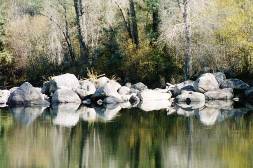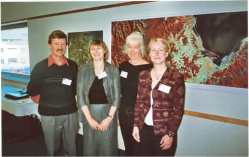Mountains to the Sea: Exploring integration and collaboration in the Motueka River catchment
A collaboration of scientists and artists
'We make landscapes according to the political system in which we operate, the economic use we see for the land, our aesthetic preferences, our social conventions - all of these summarised under the label of culture" (Joan Nassauer, 1995).

Introduction
The Mountains to the Sea initiative was a collaboration of scientists and artists drawn together to find new ways of understanding and conveying ideas about the environmental and social interconnections that shape the Motueka Catchment. It was carried out in conjunction with the Integrated Catchment Management research programme led by Landcare Research.
Such "SciArt" initiatives are a relatively new phenomenon and an extension of growing interest in bringing divergent disciplines together to encourage new insights and discoveries.
The genesis of the project was in October 2002 with a Landcare Research sponsored workshop of artists and scientists looking for common ground and ways of collaborating using talents in research, environmental understanding and creativity. Following this workshop, the Mountains to the Sea proposal was put to the pilot "Smash Palace" arts and science dialogue fund supported by the Ministry of Research, Science and Technology and Creative New Zealand, and was part-funded along with two others from a pool of 23 applications.
Mountains to the Sea involved biophysical and social science researchers from Landcare Research and two Nelson-based independent artists. It has drawn on environmental research undertaken in the Motueka River Catchment to pose the questions: What is integration and how does our understanding of integration influence the management of a catchment?
The aims of this project were twofold:
(1) to better understand how those from different disciplines can successfully work together, but foremost
(2) to produce a collaborative work that conveys and promotes an understanding of the integrated nature of the Motueka Catchment environment.
Collaboration and world-views
Mountains to the Sea aimed to do two things. Firstly, to understand more about the collaboration process between people with different worldviews. Secondly, to develop an art-science ‘work’ which would raise awareness and share understandings of the social and environmental interconnections within the Motueka River Catchment and the ICM science programme itself.
In the first phase, we tackled the challenges of being split between Nelson and Lincoln, and of differing work demands, through a three month web-based dialogue. Nelson artist and musician Ian MacDonald joined us for these digital conversations, from which excerpts have been published as "Conversations about a River". It was not intended to be just a loose exploration of working together but a means to enable us to develop the language and the working process. Our ultimate aim was to enable us to develop a collaborative work.
The dialogue started as if we were all scattered across a wide field. Arts-science collaboration was in there, as were the huge concepts of integration, mountains to the sea, working with communities. They were all in the field – somewhere! We began shouting across the landscape – gradually circling until we came together in a smaller more defined area. In the process we eventually stopped “sussing each other out” and started focusing more on what we were working on. Those conversations gestated into the concept for this Travelling River exhibition, a convergence of art, science and community.
This collaboration has progressed much like the Motueka River – starting from a spring, tumbling over rocks, converging into a channel, building to a torrent as it grows, joining other streams, gaining momentum on its journey to the sea. The exploration of ourselves, our values and our place has been evaluated as we progressed. In a TV1 interview in March 2004, Smash Palace reviewer Dr Sian Ede, Arts Director of the Calouste Gulbenkian Foundation in London, commented “the commitment and the passion that both the artists and the scientists have for this project is absolutely overwhelming, and I think it could well be a world leader”.
After the project was described at a Seattle conference on art-science eco-cultures in May 2005, conference convenor Professor Kanta Kochhar-Lindgren commented ‘I am excited to see how this work is housed in a science company. This is a cutting-edge model that I hope others will begin to think about replicating."
The SciArt Work - Travelling River
The second phase of the collaboration took the understandings gained through this dialogue to a wide and participating community audience through a 'Travelling River' exhibition.
The exhibition was held in two locations during 2004 - the Suter Gallery in Nelson (opening August 6, 2004) and in the Motueka catchment itself, at Motueka Museum in December 2004.
Travelling River combined over 250 community photographs, science images and stories from the Motueka catchment. More than sixty people contributed images and stories about their lives or their science along the river and Tasman Bay, into which it flows. The exhibition was organised around extracts from Motueka Song, by local poet Cliff Fell, Montana Book Award’s poet in 2004.
The exhibition was a “creative collision” between science, art and community aspirations for the Motueka catchment. The exhibition engendered lively debate among the more than 2500 visitors, building understanding of our science and encouraging people to think about how their environment has been modified by human and natural actions.
The project team comprised Maggie Atkinson and Suzie Peacock (Nelson artists), and Landcare Research scientists Andrew Fenemor (leader of the Motueka Integrated Catchment Management research programme), Margaret Kilvington, Chrys Horn and Chris Phillips. It developed understanding of the extensive local knowledge and the sense of place that exist among communities in rural catchments like the Motueka. Above all, it built trust for furthering our integrated catchment management (ICM) research.

The Art/Science Team October 2003.
From left - Margaret Kilvington, Chrys Horn, Maggie Atkinson, Andrew Fenemor, Chris Phillips, Suzie Peacock, Ian McDonald (initially involved but later withdrew)
Evaluation of Mountains to the Sea
Sian Ede of the UK's Gulbenkian Foundation is the Arts & Science expert who evaluated this and two other projects as part of the overall Smash Palace project.

From left to right: Andrew, Sian, Maggie and Margaret at Te Papa
Our Mountains to the Sea project and the others were presented in Wellington at Te Papa on Tuesday 23 March 2004. In addition, the two social scientists in the project also carried out an evaluation of the project and have produced a report.
Kilvington, M.; Horn C.; 2006: Mountains to the Sea: Reflections on an arts and science collaboration about the Motueka River Catchment. Published by the Manaaki Whenua/ Landcare Research Mountains to the Sea Project. ![]() 418 KB
418 KB
The Travelling River catalogue and "Conversations about a River" can be obtained from Manaaki Whenua Press.